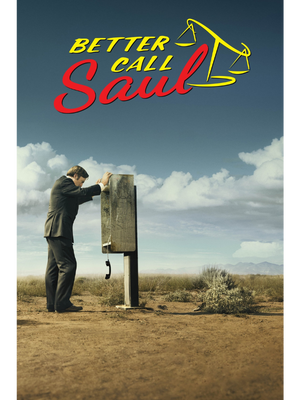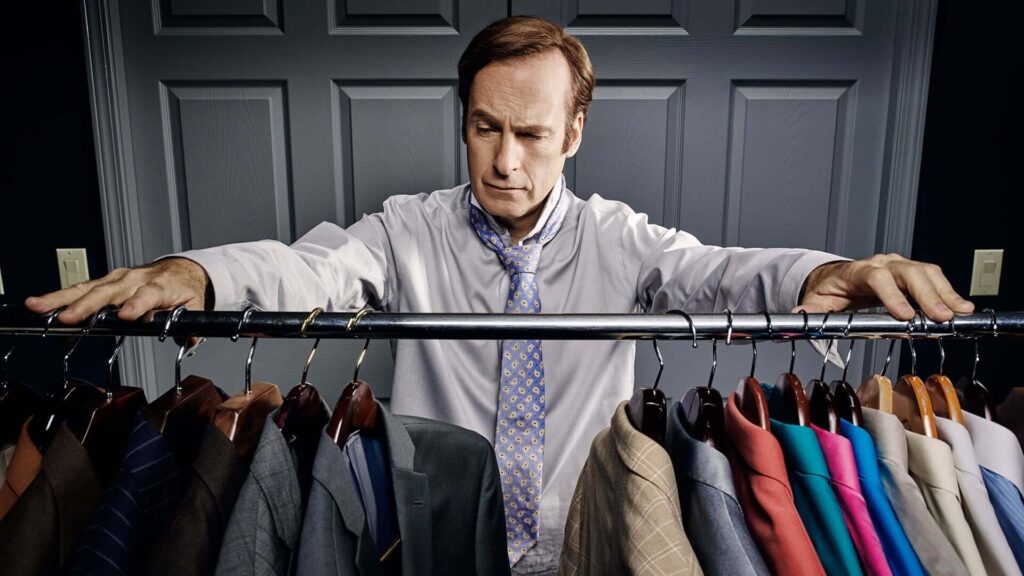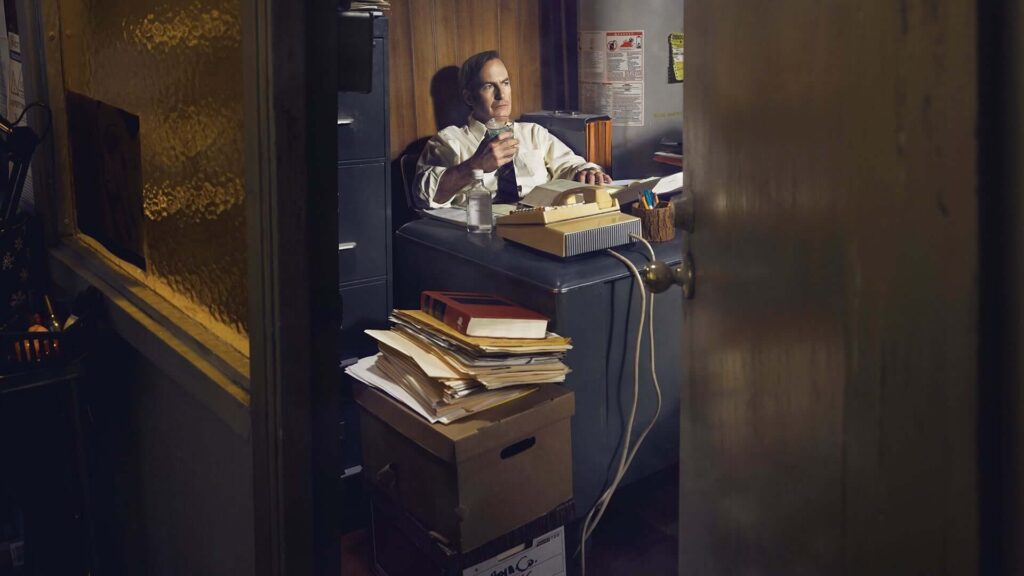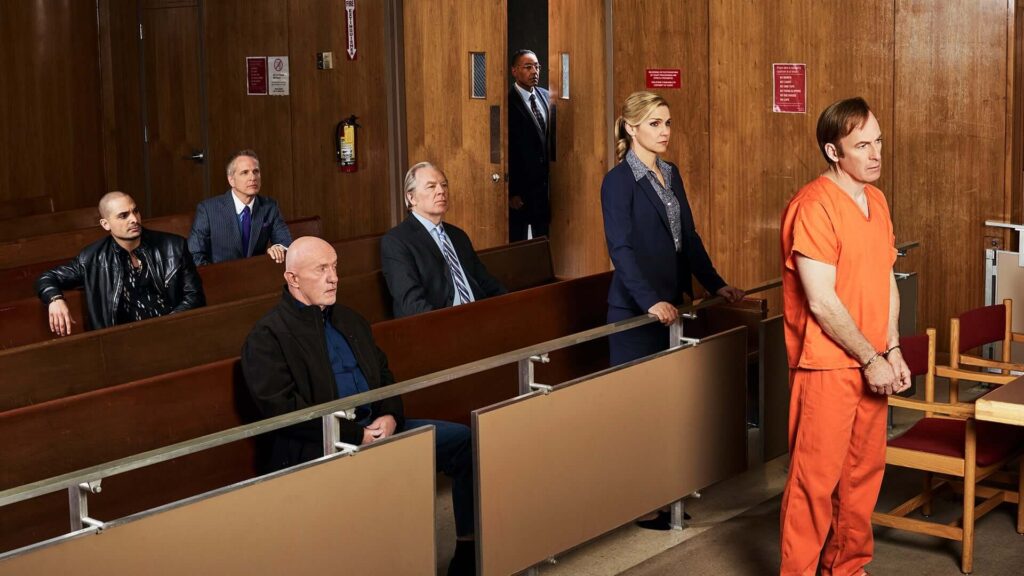Better Call Saul

TV-MA, (2015-2022), Crime/Drama, 46m
Table of Contents
What Is Better Call Saul About?
The prequel to Breaking Bad that chronicles criminal lawyer Jimmy McGill’s life before meeting Walter White and Jesse Pinkman.
Why You Should Watch Better Call Saul
Few spin-offs or prequels manage to emerge from the shadow of their original series, let alone establish themselves as standalone masterpieces. Better Call Saul not only achieves this but does so with such brilliance and finesse that it occasionally overshadows its progenitor, Breaking Bad.
Created by Vince Gilligan and Peter Gould, Better Call Saul chronicles the journey of Jimmy McGill, a small-time lawyer hustling for respect in the legal world, and his transformation into the sleazy, morally flexible attorney, Saul Goodman. While the show was initially viewed with skepticism, fearing it might be a comedic cash-grab leaning on the popularity of Breaking Bad, it quickly dispelled those notions, revealing layers of depth, emotion, and character development.

Bob Odenkirk, known primarily for comedic roles prior to this universe, delivers a tour-de-force performance as Jimmy McGill/Saul Goodman. He offers audiences a character who is both endearing and deeply flawed, a man whose every decision, whether born out of love, desperation, or ego, pulls viewers into an emotional whirlwind. Odenkirk’s portrayal of Jimmy’s transformation is subtle, making the eventual emergence of Saul Goodman a heart-wrenching revelation rather than a foregone conclusion.
However, while Jimmy/Saul is the narrative’s crux, the series’ ensemble cast is equally impressive. Rhea Seehorn’s Kim Wexler is a revelation. Her character’s evolution, complexities, and relationship with Jimmy form the series’ emotional backbone. Their bond, marked by genuine affection, shared ambitions, and ethical disparities, is a riveting exploration of love amidst personal and professional turmoil.
Michael McKean’s portrayal of Chuck McGill, Jimmy’s older brother, adds another layer of conflict. Their relationship is fraught with jealousy, pride, and a desperate need for validation. Through Chuck, the series delves into the dichotomies of mental illness, professional success, and the harsh realities of sibling rivalry. McKean’s performance is both sympathetic and infuriating, epitomizing the series’ knack for moral ambiguity.

Better Call Saul also benefits immensely from its secondary characters, with Mike Ehrmantraut (Jonathan Banks) standing out. His descent into the criminal underworld, paralleled with Jimmy’s own moral decay, offers a more action-oriented counterbalance, providing tension, intrigue, and further connecting the narrative to the events of Breaking Bad.
The series is a visual and auditory treat. Its cinematography is evocative, capturing the vastness of the New Mexican landscapes and the isolation of its characters. The show’s pacing, while deliberate, allows moments to breathe, inviting viewers to sit in contemplation with the characters. Dave Porter’s score, interspersed with a diverse array of licensed tracks, further enhances the narrative’s emotional depth and geographic setting.

Thematically rich, Better Call Saul dives into issues of identity, morality, ambition, and the nature of success. Its storylines, while often quieter than those of Breaking Bad, are no less compelling. The show’s nuanced approach to character evolution ensures that when moments of intensity do arrive, they carry an emotional heft that resonates deeply.
Better Call Saul is a triumph. It’s a testament to the genius of Gilligan, Gould, and their team, proving that with the right care, a spin-off can not only honor its original series but can carve its own impactful and enduring legacy.
The Theme of Better Call Saul
Central to the show is the evolution of Jimmy McGill into Saul Goodman. This transformation is not just a name change, but a reflection of the internal struggles of a man trying to find his place in the world. The duality of Jimmy/Saul becomes a vehicle through which the series delves into broader questions about identity. Can a person truly change? If society only rewards one version of you, which self do you embrace? Through Jimmy’s interactions with clients, colleagues, and especially his brother Chuck, the series posits that identity is fluid but constantly influenced by both internal desires and external perceptions.
The legal world in which Jimmy operates becomes a metaphorical battleground for moral and ethical dilemmas. While law theoretically operates in black and white terms, Better Call Saul highlights the shades of gray. Characters constantly navigate the blurred lines between what’s legal and what’s right. Jimmy’s actions, from small cons to larger courtroom manipulations, challenge traditional views of justice and fairness. Kim Wexler, in her own journey, grapples with the compromises one makes in the quest for success, raising questions about the true essence of integrity within the legal profession.

At its heart, Better Call Saul is about ambition – the drive to succeed and be recognized. Jimmy’s aspirations are constantly at odds with the obstacles he faces, whether they’re external, like his brother’s disdain, or internal, like his own moral compass. His attempts to break away from being a small-time lawyer and the setbacks he faces paint a poignant picture of the American Dream and its pitfalls. Similarly, characters like Mike Ehrmantraut and Gustavo Fring exemplify ambition within the criminal world, showing the sacrifices and ruthlessness required to ascend in such a perilous realm.
The series beautifully captures the complexities of human relationships. Jimmy’s bond with Kim is multifaceted – at times loving, supportive, and understanding, while at other times strained by their differing morals and ambitions. Their relationship encapsulates the challenges of maintaining personal connections in a world filled with professional and ethical conflicts. Similarly, the strained relationship between the McGill brothers sheds light on themes of jealousy, recognition, and familial obligation. On a broader scale, the series delves into the consequences of loyalty, as seen in the intricate world of cartels, where allegiance can be both a weapon and a liability.

Every action in Better Call Saul carries weight. The series excels in showing that choices, no matter how minor they seem at the moment, ripple outward with unforeseen consequences. Whether it’s Jimmy’s decision to doctor legal documents or Mike’s endeavors in the criminal underworld, choices lead to a cascade of events that shape the lives of all characters involved. This theme serves as a haunting reminder of life’s unpredictability and the irrevocable nature of certain decisions.
The Cinematography of Better Call Saul
Better Call Saul boasts a distinctive visual style that sets it apart in the television landscape. The series, spun off from Breaking Bad, inherits some of its predecessor’s cinematic qualities but crafts its own unique aesthetic.
Foregrounding its New Mexico setting, the series often employs wide shots that capture the vastness and beauty of the desert landscapes, evoking a sense of isolation and contemplation. These expansive exteriors contrast sharply with the tight, intimate close-ups used in character-driven moments, emphasizing the depth and nuance of individual journeys.

The show’s use of color is meticulous and symbolic. Colors like the bright, often garish suits worn by Jimmy/Saul, or Kim Wexler’s often neutral palette, not only reflect character personalities but also their moral landscapes and evolving arcs. As with Breaking Bad, color becomes an evolving tapestry that hints at transformation, allegiances, and moral shifts.
The series frequently employs innovative camera techniques. From unique angles to prolonged tracking shots, the cinematography often invites viewers to see the world through the skewed, unconventional lens of its protagonist, Jimmy McGill. One notable technique is the use of point-of-view shots that place the audience directly in the perspective of characters, creating an immersive experience.
Better Call Saul is lauded for its patient pacing. Scenes are allowed to breathe, and this is reflected in the cinematography with extended takes and a reluctance to cut away too quickly. This deliberate pacing, coupled with the show’s visual style, creates a meditative atmosphere that encourages viewers to contemplate character motivations and the broader thematic implications of their actions.
The Soundtrack of Better Call Saul
The soundtrack of Better Call Saul is integral to its storytelling, carrying forward the legacy of its predecessor, Breaking Bad, but establishing its unique auditory identity. The series adeptly blends a range of musical styles, including classic rock, Spanish-language tracks, and original scores that perfectly capture the essence of the American Southwest and the morally complex universe of its characters.
Composer Dave Porter, who also worked on Breaking Bad, provides the show’s original score. His compositions oscillate between quirky, playful tunes reflecting Jimmy’s roguish charm, and intense, moody pieces capturing the series’ darker moments and the foreboding world of cartel crime.

The licensed tracks complement character arcs, foreshadow plot developments, or simply set the scene’s mood. Many songs, while not necessarily mainstream hits, become indelibly linked to key series moments due to their astute placement.
Some memorable songs from the series include:
- “Smoke on the Water” by Deep Purple – This classic rock staple is played during a flashback of Jimmy’s days in Cicero.
- “Something Stupid” by Lola Marsh – A cover of the famous track, used in a split-screen montage showing the growing divide between Jimmy and Kim.
- “Bali Ha’i” by Juanita Hall – Used in a scene where Kim is waiting for a call, highlighting her internal conflict.
- “Piñata” by the Madrigal Electromotive Security Team – An original, humorous song, indicative of the show’s occasional comedic touches.
- In sum, the soundtrack of Better Call Saul enhances its narrative, blending the nostalgic, the dramatic, and the whimsical, creating an audio backdrop as intricate and compelling as its visual counterpart.
Below is a playlist inspired by the show
The Cast of Better Call Saul
- Bob Odenkirk as Jimmy McGill/Saul Goodman: A small-time lawyer with a flair for dramatic courtroom stunts, who grapples with his sense of morality as he slowly transforms into the sleazy lawyer, Saul Goodman.
- Rhea Seehorn as Kim Wexler: A dedicated and talented lawyer who is Jimmy’s romantic and professional partner. As Jimmy evolves, she finds herself wrestling with her own moral compass.
- Jonathan Banks as Mike Ehrmantraut: A former Philadelphia police officer working for Madrigal Electromotive’s parking lot and a private investigator, head of corporate security, and fixer for Gus Fring, with a dark past and specialized skills.
- Michael McKean as Chuck McGill: Jimmy’s older brother, a brilliant lawyer who helped found the major law firm Hamlin, Hamlin & McGill (HHM), but suffers from electromagnetic hypersensitivity, a condition which, controversially, he believes prevents him from being around anything electronic.
- Patrick Fabian as Howard Hamlin: The managing partner of HHM who often finds himself at odds with Jimmy, but is deeply respectful and protective of Chuck, his mentor and partner.
- Michael Mando as Nacho Varga: A career criminal and high-ranking member of the Salamanca drug ring. He’s more calculated than his contemporaries, leading to some conflicts within the criminal underworld.
- Giancarlo Esposito as Gustavo “Gus” Fring: A methamphetamine distributor who presents himself as a legitimate businessman, running a chain of fast-food chicken restaurants called Los Pollos Hermanos.
- Tony Dalton as Lalo Salamanca: A charismatic, high-ranking member of the Salamanca family, involved in the drug trade. Unlike other members of his family, Lalo takes an interest in the day-to-day operations of his business and often gets hands-on.
- Mark Margolis as Hector Salamanca: A former high-ranking member of the Juárez Cartel and uncle to Lalo, Leonel, and Marco Salamanca. He’s bound to a wheelchair and communicates using a bell, due to a stroke.

The Filmmakers of Better Call Saul
- Vince Gilligan – Co-creator, writer, director, and executive producer. Gilligan is also the creator of Breaking Bad, the show from which Better Call Saul is a prequel.
- Peter Gould – Co-creator, writer, director, and executive producer. Gould was also a key writer and producer for Breaking Bad and is credited with creating the character of Saul Goodman.
Throughout its run, Better Call Saul has had multiple directors, writers, and producers contributing to various episodes. Some of these include:
- Thomas Schnauz – Writer, director, and executive producer.
- Michael Morris – Director.
- Melissa Bernstein – Executive producer.
- Gennifer Hutchison – Writer and executive producer.
- Gordon Smith – Writer and producer.
- Ann Cherkis – Writer.
- Nina Jack – Producer.

Cinnabon Delights

Inspiration
Gene Takavic, Cinnabon Employee in Omaha, Nebraska

More About Better Call Saul
In Better Call Saul, the backstory of Mike Ehrmantraut, a character originally introduced in Breaking Bad, is fleshed out in more detail, particularly concerning the tragic fate of his son, Matty Ehrmantraut.
Matty, Mike’s only son, was a rookie police officer in the Philadelphia Police Department. As we learn through Mike’s interactions and flashbacks, Matty was faced with a moral dilemma when he discovered that some fellow officers, including his partners Troy Hoffman and Jack Fensky, were involved in corrupt activities. They were skimming money from illegal activities, a common but unspoken practice within their precinct.
When Matt faced this ethical crossroads, he confided in his father, Mike, who was a seasoned cop at the time. Mike advised him to go along with the scheme for his safety, fearing retaliation if Matty took a stand against the corruption. Despite his reservations, Matty heeded his father’s advice.

However, Hoffman and Fensky grew suspicious of Matty’s initial hesitation and feared he might expose them. In a tragic turn of events, they set up an ambush and murdered him, making it appear as a random act of street violence.
This event devastated Mike and became the catalyst for his departure from the police force and his eventual move to Albuquerque. Fueled by grief and rage, Mike later exacted revenge on Hoffman and Fensky, killing them both. Matty’s death haunted Mike throughout Better Call Saul, shaping his actions, moral choices, and relationship with his beloved granddaughter, Kaylee.
Better Call Saul, much like its predecessor Breaking Bad, was predominantly filmed in Albuquerque, New Mexico, a location that has since become synonymous with the narrative and visual identity of both series. Albuquerque provides a vibrant, unique backdrop that plays a crucial role in setting the atmosphere of the show. Its expansive desert landscapes, characteristic Southwestern architecture, and dynamic urban environments contribute significantly to the series’ distinctive visual palette.
The decision to shoot in Albuquerque was not just based on aesthetics but also on the authentic atmosphere the city brings to the narrative. From its local diners and courtrooms to the vast desert stretches that have hosted many pivotal moments in the series, Albuquerque is as much a character in Better Call Saul as the individuals portrayed by the cast. Locations like the Crossroads Motel, Loyola’s Family Restaurant, and the iconic parking lot booth where Mike Ehrmantraut often works, have become landmarks for fans.

